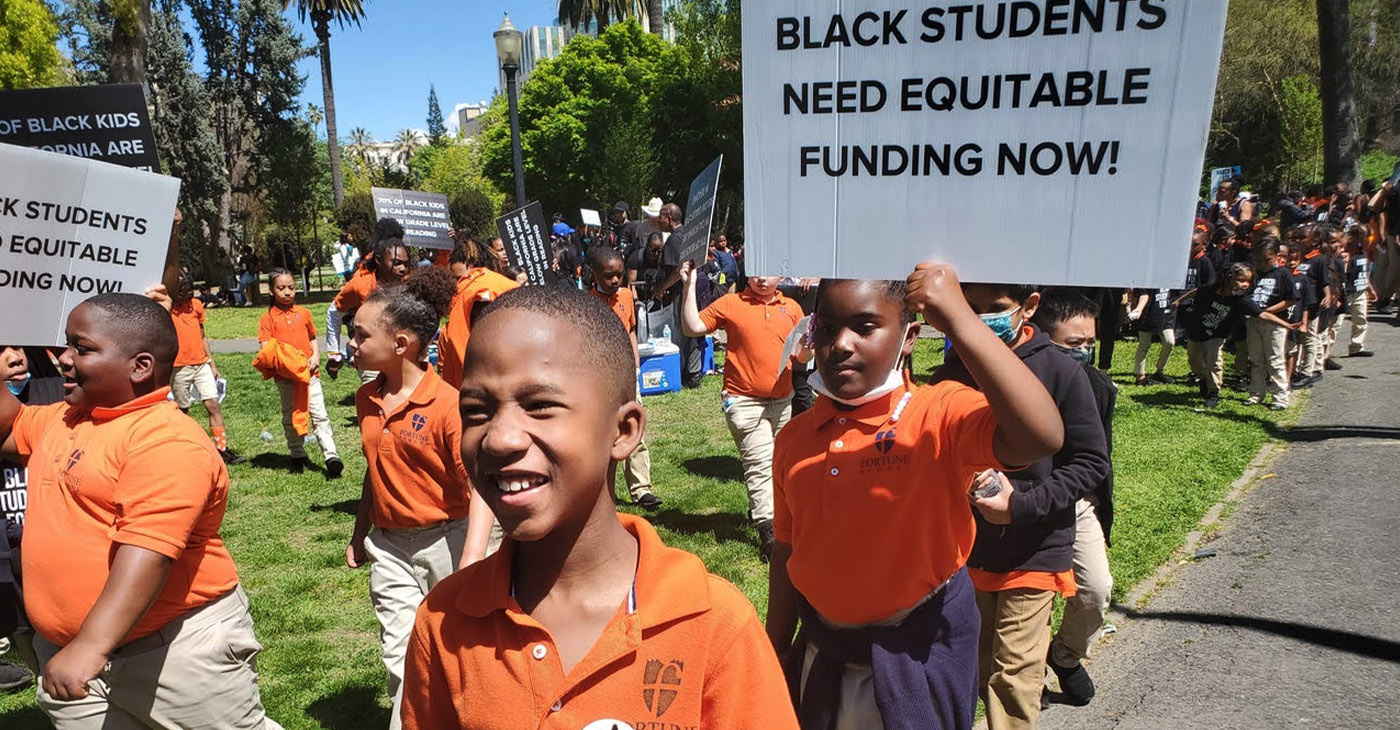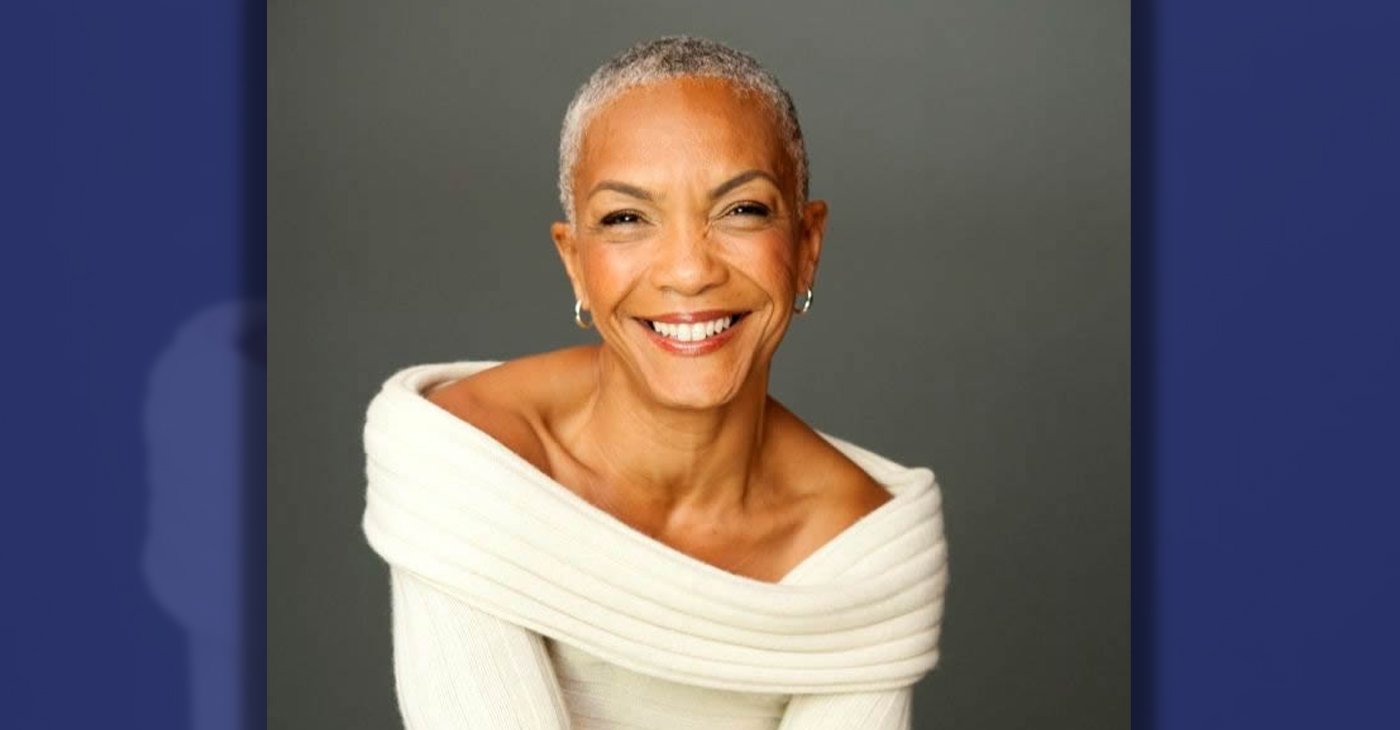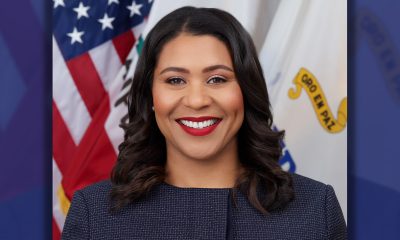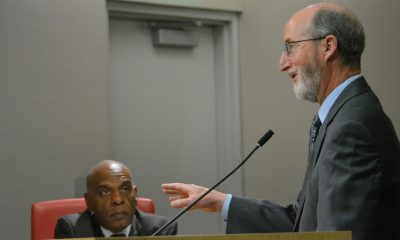California Black Media
Gov. Newsom and Advocates at Impasse Over Funding for Black Students Education
Last week, at the invitation of the Black in School Coalition (BISC), over 2,500 K-12 students, parents, education advocates, and civil rights leaders marched to the California State Capitol to demand increased funding for Black students in the state’s public schools. BISC is a statewide advocacy association consisting of 17 organizations from all parts of the education community, including teachers, administrators, local school districts and county board of education trustees, parents, civil rights, and faith groups.

Joe W. Bowers Jr. | California Black Media
Last week, at the invitation of the Black in School Coalition (BISC), over 2,500 K-12 students, parents, education advocates, and civil rights leaders marched to the California State Capitol to demand increased funding for Black students in the state’s public schools.
BISC is a statewide advocacy association consisting of 17 organizations from all parts of the education community, including teachers, administrators, local school districts and county board of education trustees, parents, civil rights, and faith groups.
The BISC marchers were calling on Gov. Gavin Newsom and the California Legislature to not move forward with the “Equity Multiplier” proposed in the governor’s Education Budget, which is supposed to be a substitute for Assembly Bill (AB) 2774 authored by Assemblymember Akilah Weber (D – La Mesa).
AB 2774 would have guaranteed funding for California’s lowest performing group, Black students, but advocates say, Newsom’s proposal falls short of that goal.
Because Newsom raised concerns that targeting funds to a specific group of students would violate Prop 209, which prevents preferential treatment based on race, Weber withdrew AB 2774. In exchange, Newsom agreed to increase funding for Black students under the Local Control Funding Formula (LCFF) in the 2023 budget.
The LCFF is a state law that provides funding to local school districts based on the needs of their students. California’s highest-needs student populations receiving supplemental funding for additional support are English Language Learners, low-income students, and children in foster care or homeless youth. However, despite chronic underperformance, Black students are not identified as a high-needs population for funding.
According to state data, in the 2021-22 academic year, 30% of California’s Black students met English standards and 15% met math standards, compared to 61% and 48% of White students meeting reading and math standards, respectively.
The equity multiplier proposal provides $300 million in ongoing Proposition 98 funding to the LCFF to accelerate gains in closing opportunity and outcome gaps. The funds are allocated to school districts with schools serving high concentrations of students eligible for free meals.
The equity multiplier is part of Newsom’s plan to overhaul how the state can hold districts and schools accountable for student performance, with particular attention to racial disparities. According to Newsom’s office, 95% of Black students in California will be impacted because they are enrolled in districts potentially facing new accountability requirements due to low performance.
Dr. Margaret Fortune, president and CEO of the charter school organization Fortune School of Education and the lead voice for BISC says Newsom’s proposal sounds good but does not reflect the intentions of Weber’s bill.
According to an analysis conducted by EdSource, the funding from Newsom’s proposal would benefit about 6% of Black students statewide and they would be receiving an estimated $18 million out of $300 million proposed. Overall, the proposal targets just 5% of students in the state in about 800 schools and the students reached in those schools are mostly Latino.
To address this disparity in funding for Black students not in low-income schools, BISC has developed an alternative plan to the Equity Multiplier. It proposes additional funding for any group not already funded that scores below the state average on any two metrics on the California School Dashboard. Based on this year’s dashboard results, Black and Native American students would qualify.
Because students who have received LCFF funding have shown progress and improved outcomes due to concentrated resources aimed at their improvement, BISC’s funding alternative intentionally provides Black students the additional support that has benefited high-needs student groups.
Prior to their march on the Capitol, members of the BISC and students provided public comments at the State Assembly’s education budget committee hearing in support of their alternative budget proposal.
Fortune suggested to the committee that the $300 million in the governor’s equity multiplier proposal be directed to student groups who perform below the state average on two or more state indicators on the California school dashboard. This would increase per-student funding from $713 under the governor’s proposal to $3,318 for students in California with the greatest academic needs.
Under the BISC alternative plan, an additional 81,617 Black students and 8,807 Native American students would be eligible for this funding, compared to an additional 22,699 Black students and 1,806 Native American students under Newsom’s proposal.
Christina Laster, Western Regional Education Director of the National Action Network, stated that not many Black students attend the low-income schools targeted by the governor’s equity multiplier. Instead, she recommends focusing on student groups who perform below the state average on two or more state indicators on the California school dashboard. This would target student groups in the most academic need based on their performance, not their race.
Dr. Ramona Bishop, CEO of ELITE Public Schools, urged the Legislators to consider the BISC alternative proposal for the equity multiplier, which would address the needs of the students who stood behind her as she spoke. She emphasized that all Black students in the state deserve care, attention, and the best efforts of those in power.
Izzy Gardon, a spokesperson for the governor said, “We share the ultimate goal of the Black in School Coalition to eliminate opportunity and achievement gaps for Black students. However, we continue to believe that our more comprehensive and legally sound proposal is a better option than AB 2774 and its related alternative proposal. We are not alone in that belief — as I believe you have seen, we have the support of members of the CLBC (California Black Legislative Caucus including Weber), CAAASA (California Association of African American Superintendents), the Superintendent of Public Instruction (Tony Thurmond) and many others.”
So BISC and Newsom are at an impasse at what is the best way to direct state funding for educating Black students in the public schools.
BISC wants funding targeting Black students based on their need for support due to poor academic performance, while Newsom’s Equity Multiplier focuses on schools with high concentrations of poverty, impacting about 6% of the state’s Black students.
Newsom is concerned about the legal implications of funding aimed at specific racial groups and aims to reform the LCFF to address underperforming racial groups. BISC, on the other hand, is focused solely on Black student funding and not on reforming LCFF.
But the California Department of Justice (DOJ) in a preliminary report it wrote for the Task Force to Study and Develop Reparation Proposals for African Americans recommended funding Black students through the state’s funding formula, suggesting that Newsom should not be so concerned about violating Prop 209.
A recent report from the Legislative Analyst’s Office complicates the debate by noting that high-poverty schools already receive targeted funding and recommending that the Legislature not approve funding for the Equity Multiplier.
Until a solution to the impasse is achieved, the state must persist in its efforts to identify and implement the appropriate policy to assist its Black students in improving their academic performance, based on their individual needs rather than their race.
California Black Media
Expect to See a New Flat Rate Fee of $24 on Your Electricity Bill
Last week, members of the California Public Utilities Commission voted to approve adding a $24.15 flat fee to monthly utility bills starting next year. On May 9, the California regulators took the unanimous vote in favor of the proposal which also reduced the cost of utilities per kilowatt hour but added the fixed charge to mitigate the loss. The new charge will be based on income with lower-income households paying between $6 to $12. Middle-class to high-income households will be expected to pay the full amount.

By California Black Media
Last week, members of the California Public Utilities Commission voted to approve adding a $24.15 flat fee to monthly utility bills starting next year.
On May 9, the California regulators took the unanimous vote in favor of the proposal which also reduced the cost of utilities per kilowatt hour but added the fixed charge to mitigate the loss. The new charge will be based on income with lower-income households paying between $6 to $12. Middle-class to high-income households will be expected to pay the full amount.
CPUC President Alice Reynolds and environmental groups argue that the new rate encourages people to use more clean energy and assist in modernizing the grid.
“We’re marching towards the future we want to see; we want this load growth,” Reynolds said.
“One where we can replace gas-guzzling cars on our roads with EVs that run on clean electricity and emit less pollutants,” she added.
Although the fixed charge is supposed to lower the utility bill for residents, opponents of the charge argue that a flat rate increases the monthly bill for middle and high-income households.
California currently operates under a prepaid model and maintenance of the power grid is included in the overall usage rate. But with this new proposal, residents will pay more than double the national average of $11 for electricity.
Cynthia Martinez, a spokesperson for the Predictable Power Coalition, an advocacy group, argued that a flat rate is more equitable and will reduce the cost of utilities for struggling families.
“For people who live in hotter climates, who really have no choice but to run their air conditioning more often, they’re paying higher costs that go toward grid upkeep,” Martinez said.
In the past, Democrats stalled plans at the state Capitol to approve the flat fee. All 14 Democrats in the Senate Energy, Utilities, and Communications Committee abstained from voting during a hearing on the proposal to roll back the flat rate.
California Black Media
Commentary: Support Early Detection Technology to Save the Lives of Black Cancer Patients
In 2008, I received news no one ever wants to hear. I was diagnosed with Stage I breast cancer, with an ER/PR positive tumor type. The road to recovery was tough, taking more than a physical toll on my body. I grappled with the emotional and mental strain of navigating a health care system that too often fails to address the unique needs of Black women. There was no manual to guide me through this journey, no prescription to ease the burden, and no roadmap to help me navigate the challenges ahead.

By Rhonda Smith, Special to California Black Media Partners
In 2008, I received news no one ever wants to hear. I was diagnosed with Stage I breast cancer, with an ER/PR positive tumor type.
The road to recovery was tough, taking more than a physical toll on my body. I grappled with the emotional and mental strain of navigating a health care system that too often fails to address the unique needs of Black women. There was no manual to guide me through this journey, no prescription to ease the burden, and no roadmap to help me navigate the challenges ahead.
The stark reality that Black women are 41% more likely to die from breast cancer than White women is a grim reminder of the systemic inequities that pervade our health care system. According to the American Cancer Society, Black Americans have the highest death rate and shortest survival rate of any racial or ethnic group in the country. This disparity extends beyond breast cancer, impacting colorectal, prostate, and lung cancers, among others.
To help overcome these inequities, we need to attack cancer at its roots; we must catch it early, and we must ensure the means to catch cancer early are accessible to the communities most at risk. I consider myself fortunate to have received a Stage 1 diagnosis. Yet, it pains me to know that for many others, their breast cancer is often detected in later, more advanced stages.
Fortunately, there is hope on the horizon. Some California congressmembers — particularly U.S. Rep. Raul Ruiz (D-CA-25) — are taking decisive action. Ruiz is a lead sponsor of a bill to dramatically expand access to cutting-edge early detection tools for Medicare beneficiaries, including millions of Black Americans in underserved communities. With bipartisan support, this bill is closer than ever to passage.
Named in honor of Nancy Gardner Sewell, a civil rights leader and passionate advocate for health justice, the Nancy Gardner Sewell Medicare Multi-Cancer Early Detection Screening Coverage Act would ensure Medicare has the latitude it needs to cover an exciting new class of cancer detection tests as soon as they’re cleared by the FDA.
These tests utilize the latest scientific achievements to identify cancer signals in a patient’s blood stream. They can pinpoint many different types of cancer from a single blood draw, dramatically improving doctors’ ability to detect cancers early and at stages where they are most treatable.
The next phase of our fight against cancer – and the disproportionate toll it takes on Black Americans – starts by urging Congress to pass the Nancy Gardner Sewell Medicare Multi-Cancer Early Detection Screening Coverage Act and ensuring the benefits of this legislation reach all corners of our communities.
I don’t advocate for change for myself, but for every Black woman who has faced, or will face, a similar battle.
Together, we can rewrite the narrative of health care, catch and treat cancer early, and ensure that every woman has the opportunity to thrive, regardless of her race or background.
About the Author
Rhonda Smith, Executive Director of the California Black Health Network, leads initiatives to advance health equity for Black Californians, leveraging her expertise from roles including consulting and spearheading health disparities initiatives for BIPOC communities. With an MBA from the University of Virginia’s Darden School of Business and a B.S. in Civil Engineering from Virginia Tech, Rhonda has led transformative projects like the LiveHealthy OC Initiative and the Susan G. Komen® Circle of Promise California Initiative to address health disparities and promote whole person care approaches.
Bay Area
California Makes Strides in Fight Against Fentanyl
California National Guard’s Counterdrug Task Force has seized over 7,000 pounds of fentanyl including 3.4 million pills since the state launched a multi-agency operation in January 2024. Gov. Gavin Newsom announced the state’s progress on May 7, National Fentanyl Awareness Day. The Governor said he deployed the state’s highway patrol and National Guard personnel last year as part of a public safety operation in partnership with local government officials and law enforcement.

By California Black Media
California National Guard’s Counterdrug Task Force has seized over 7,000 pounds of fentanyl including 3.4 million pills since the state launched a multi-agency operation in January 2024.
Gov. Gavin Newsom announced the state’s progress on May 7, National Fentanyl Awareness Day.
The Governor said he deployed the state’s highway patrol and National Guard personnel last year as part of a public safety operation in partnership with local government officials and law enforcement.
“As we recognize the serious dangers of illegal fentanyl, California is continuing to tackle this issue head-on. Our efforts are getting this poison off our streets and out of our communities as we continue to support people struggling with substance use.” Newsom said.
CalGuard Major General Matthew Beevers said that the state’s unprecedented investment in the Counterdrug Task Force has immobilized operations and revenue channels of transnational criminal organizations.
“The CalGuard is committed to supporting our state, federal, local and tribal law enforcement partners to eliminate the scourge of fentanyl,” Beevers said.
In the past five years, California has invested $1.1 billion in operations and initiatives to fight crime, support local law enforcement, and improve public safety. The Newsom administration has implemented a comprehensive approach as part of the governor’s Master Plan to tackle the fentanyl and opioid crisis.
The Newsom administration has expanded efforts to improve public safety across the state where operations occurred in cities such as San Francisco, Oakland, and Bakersfield.
San Francisco Mayor London Breed acknowledged that joint operation was a step in the right direction toward curbing illegal activity and improving public safety.
“Our coordinated work to shut down drug markets in San Francisco is making a difference, but we have more work to do,” Breed said.
“Together we are sending a message at all levels of government that anyone selling fentanyl in this city will be arrested and prosecuted,” she said.
-

 City Government2 weeks ago
City Government2 weeks agoCourt Throws Out Law That Allowed Californians to Build Duplexes, Triplexes and RDUs on Their Properties
-

 Activism3 weeks ago
Activism3 weeks agoOakland Post: Week of April 24 – 30, 2024
-

 Community4 weeks ago
Community4 weeks agoOakland WNBA Player to be Inducted Into Hall of Fame
-

 Community4 weeks ago
Community4 weeks agoRichmond Nonprofit Helps Ex-Felons Get Back on Their Feet
-

 Community4 weeks ago
Community4 weeks agoRPAL to Rename Technology Center for Retired Police Captain Arthur Lee Johnson
-

 Alameda County2 weeks ago
Alameda County2 weeks agoAn Oakland Homeless Shelter Is Showing How a Housing and Healthcare First Approach Can Work: Part 1
-

 Business4 weeks ago
Business4 weeks agoBlack Business Summit Focuses on Equity, Access and Data
-

 Bay Area4 weeks ago
Bay Area4 weeks agoMAYOR BREED ANNOUNCES $53 MILLION FEDERAL GRANT FOR SAN FRANCISCO’S HOMELESS PROGRAMS


















































